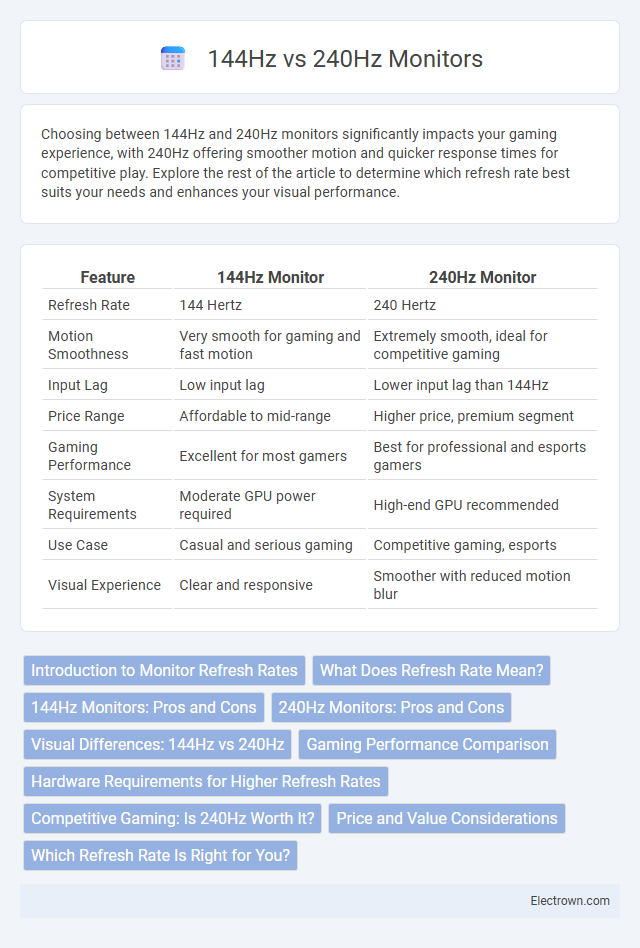Choosing between 144Hz and 240Hz monitors significantly impacts your gaming experience, with 240Hz offering smoother motion and quicker response times for competitive play. Explore the rest of the article to determine which refresh rate best suits your needs and enhances your visual performance.
Table of Comparison
| Feature | 144Hz Monitor | 240Hz Monitor |
|---|---|---|
| Refresh Rate | 144 Hertz | 240 Hertz |
| Motion Smoothness | Very smooth for gaming and fast motion | Extremely smooth, ideal for competitive gaming |
| Input Lag | Low input lag | Lower input lag than 144Hz |
| Price Range | Affordable to mid-range | Higher price, premium segment |
| Gaming Performance | Excellent for most gamers | Best for professional and esports gamers |
| System Requirements | Moderate GPU power required | High-end GPU recommended |
| Use Case | Casual and serious gaming | Competitive gaming, esports |
| Visual Experience | Clear and responsive | Smoother with reduced motion blur |
Introduction to Monitor Refresh Rates
Monitor refresh rates measure how many times per second a display updates its image, expressed in Hertz (Hz). A 144Hz monitor refreshes the screen 144 times per second, offering smoother motion compared to standard 60Hz displays, while a 240Hz monitor increases this frequency to 240 times per second for even more fluid visuals. Higher refresh rates reduce motion blur and input lag, benefiting gamers and users requiring fast, responsive screen performance.
What Does Refresh Rate Mean?
Refresh rate refers to the number of times per second a monitor updates the displayed image, measured in hertz (Hz). A 144Hz monitor refreshes the image 144 times per second, providing smoother motion and reduced motion blur compared to standard 60Hz displays, while a 240Hz monitor refreshes 240 times per second, offering even more fluid visuals ideal for competitive gaming. Higher refresh rates contribute to improved responsiveness and clarity, especially in fast-paced gameplay where every millisecond counts.
144Hz Monitors: Pros and Cons
144Hz monitors offer a significant improvement over standard 60Hz displays, delivering smoother motion and reduced screen tearing, which benefits gamers and video editors by enhancing visual clarity and responsiveness. They are generally more affordable and widely compatible with a variety of graphics cards compared to 240Hz monitors, making them accessible for mid-range systems. However, 144Hz displays may show less fluidity in extremely fast-paced gaming scenarios when compared to the ultra-high refresh rate of 240Hz monitors, which can limit the competitive edge sought by professional esports players.
240Hz Monitors: Pros and Cons
240Hz monitors deliver ultra-smooth visuals with extremely high refresh rates ideal for competitive gaming, reducing motion blur and providing a significant edge in fast-paced scenarios. However, they demand powerful hardware to consistently achieve high frame rates, and the visual difference compared to 144Hz monitors may be less noticeable for casual users. Your choice should balance performance needs and budget, as 240Hz monitors typically come at a higher cost.
Visual Differences: 144Hz vs 240Hz
A 240Hz monitor offers smoother motion clarity and reduced motion blur compared to a 144Hz display, enhancing fast-paced gaming and high-frame-rate video playback. While both refresh rates provide noticeable improvements over standard 60Hz monitors, the jump from 144Hz to 240Hz yields subtler visual differences that are most perceptible in competitive gaming or rapid screen movements. Your experience will largely depend on the capability of your graphics card to output consistently high frame rates matching the monitor's refresh rate.
Gaming Performance Comparison
A 240Hz monitor offers smoother motion rendering and reduced input lag compared to a 144Hz display, resulting in more responsive and fluid gameplay, especially in fast-paced competitive games like first-person shooters and racing titles. Gamers benefit from higher frame rates aligning with 240Hz panels, enabling quicker reaction times and improved target tracking accuracy. However, the perceptible difference in gaming performance between 144Hz and 240Hz decreases on lower-end hardware or less demanding games where frame rates seldom exceed 144fps.
Hardware Requirements for Higher Refresh Rates
Monitors with refresh rates of 240Hz demand significantly more powerful hardware compared to 144Hz displays, requiring high-end GPUs capable of consistently delivering frame rates close to the monitor's refresh rate to fully benefit from smoother visuals. Your PC must have not only a robust graphics card but also a fast CPU and sufficient RAM to prevent bottlenecks that limit performance at such high refresh rates. Ensuring your system meets or exceeds these hardware requirements is essential to unlock the full potential of 240Hz monitors without experiencing frame drops or stuttering.
Competitive Gaming: Is 240Hz Worth It?
In competitive gaming, a 240Hz monitor offers smoother motion clarity and reduced input lag compared to a 144Hz display, providing a tangible advantage in fast-paced titles like FPS and racing games. The higher refresh rate enhances frame transitions, allowing players to react more quickly and precisely, which can be crucial in high-level play. However, the perceptible improvement depends on the player's skill, hardware capabilities, and game optimization, making 240Hz most beneficial for esports professionals or enthusiasts seeking every millisecond advantage.
Price and Value Considerations
144Hz monitors generally offer a balanced combination of performance and affordability, making them ideal for gamers and users seeking smooth visuals without a substantial investment. 240Hz monitors, while significantly more expensive, provide ultra-smooth motion clarity ideal for competitive eSports players who need the smallest input lag and fastest response times. The value proposition depends on user priority; 144Hz monitors provide excellent price-to-performance for most users, whereas 240Hz variants justify their premium cost primarily in professional or highly competitive gaming environments.
Which Refresh Rate Is Right for You?
Choosing between 144Hz and 240Hz monitors depends on your gaming preferences and hardware capabilities. A 144Hz monitor offers a smooth experience ideal for most gamers, while 240Hz provides ultra-fluid motion for competitive esports players seeking every millisecond advantage. Your decision should balance refresh rate benefits with your graphics card's performance and the types of games you play.
144Hz vs 240Hz Monitors Infographic

 electrown.com
electrown.com